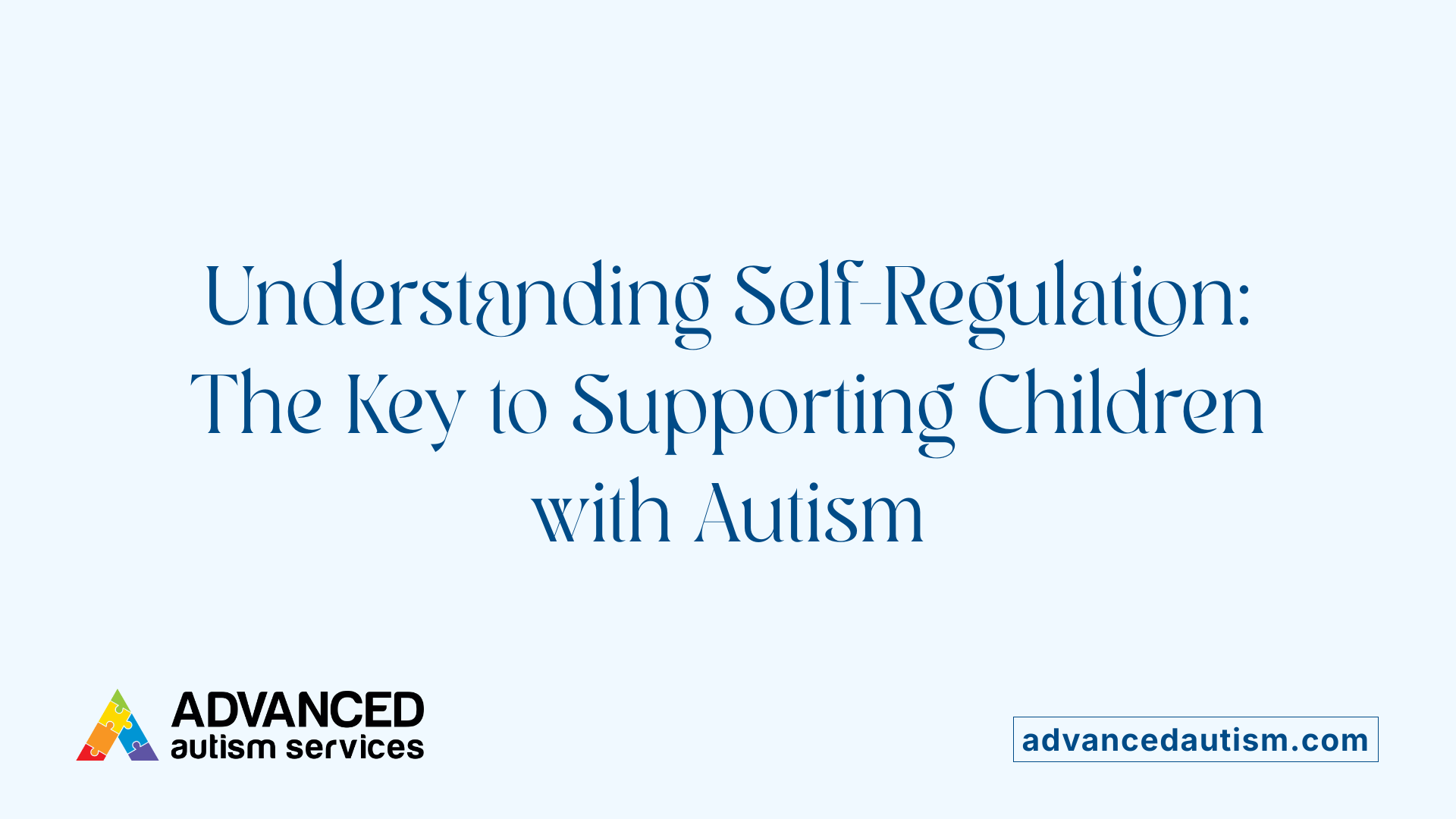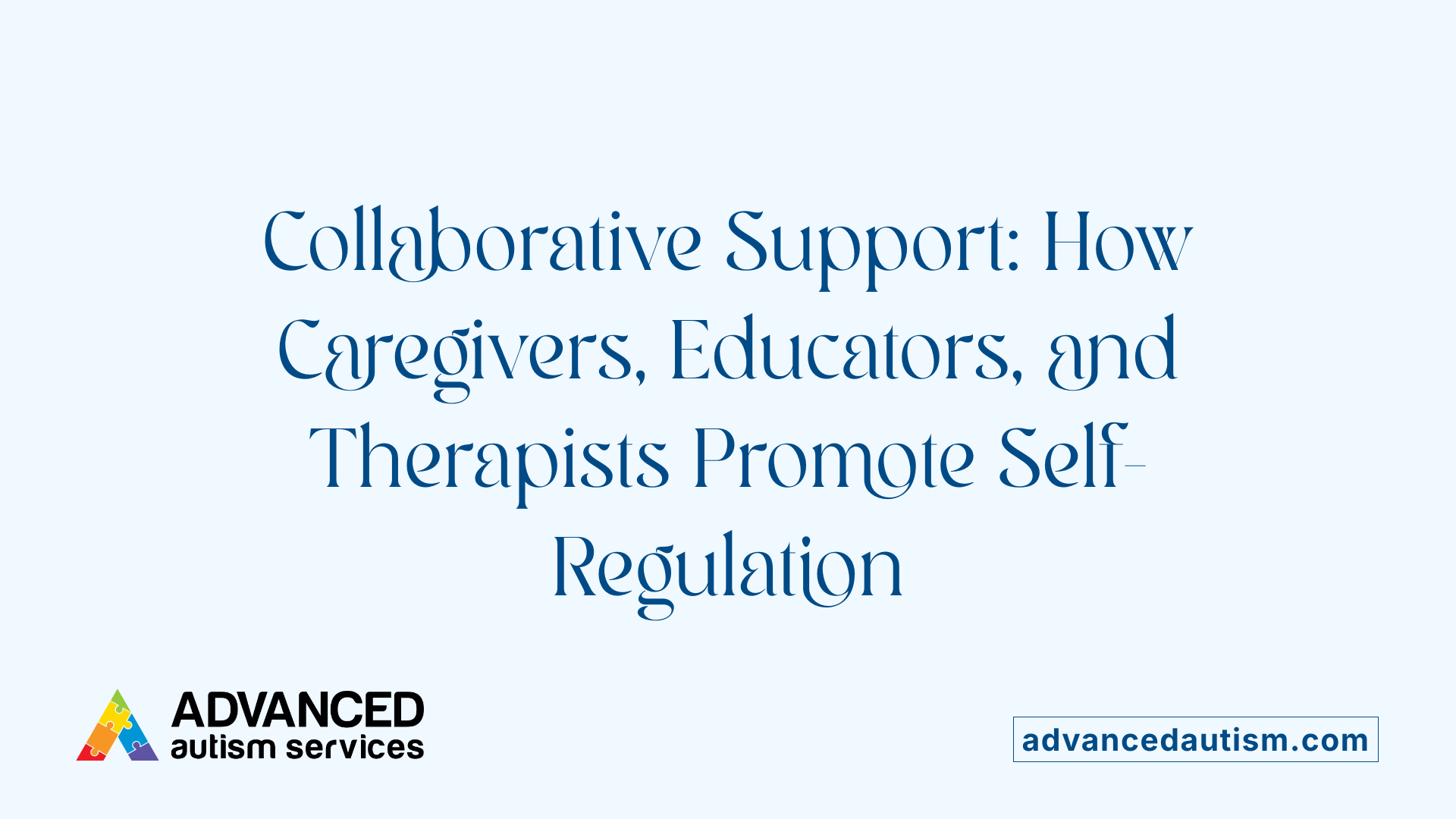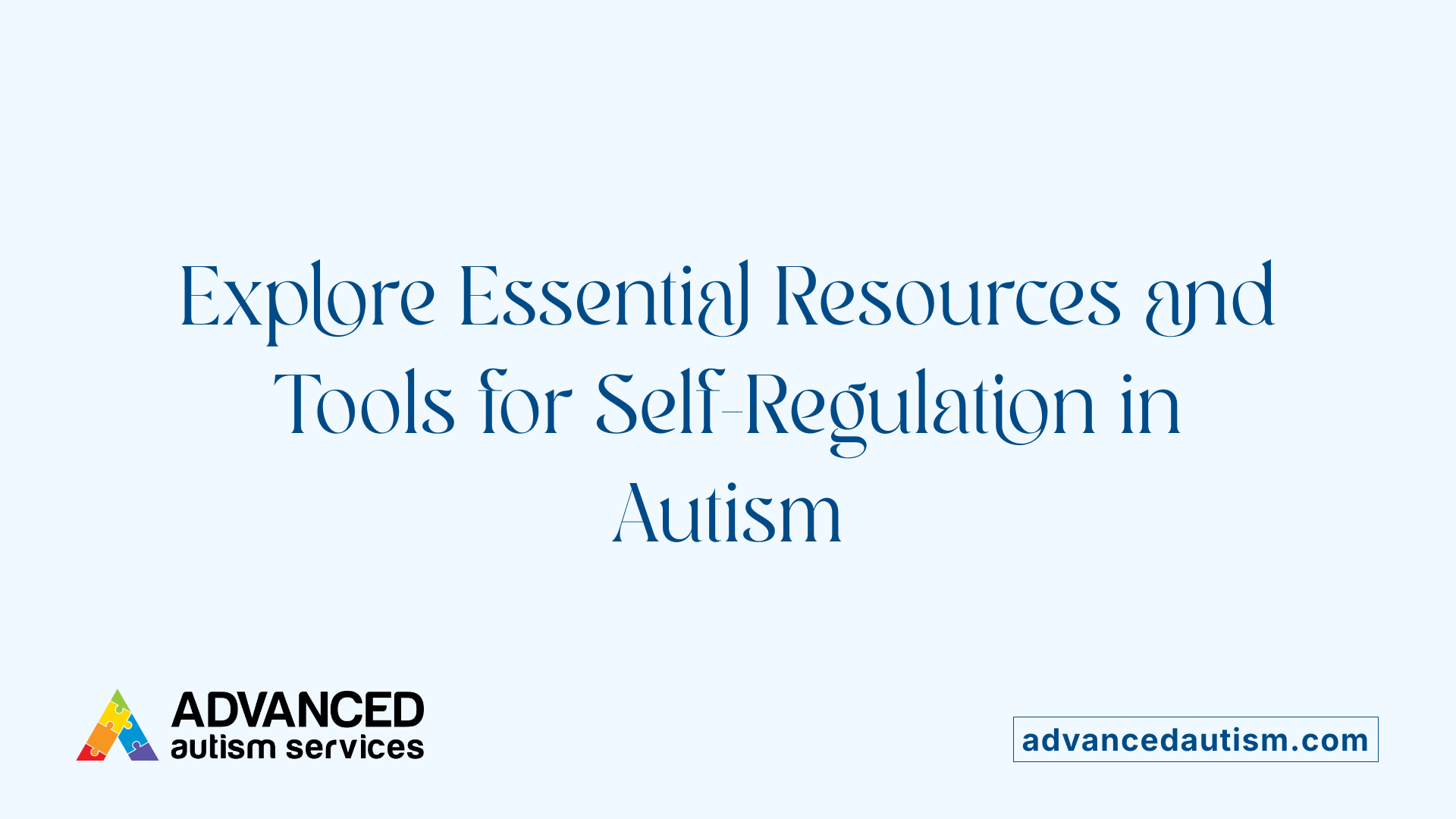Understanding the Foundation of Self-Regulation in Autism
Supporting children with autism in developing effective self-regulation techniques is crucial for their emotional well-being, social interaction, and overall development. Self-regulation encompasses managing thoughts, emotions, and behaviors adaptively across different environments and stimuli. For children with autism, this skill is often challenged by sensory sensitivities, language delays, and emotional regulation difficulties, leading to behaviors like meltdowns, impulsivity, and mood swings. Recognizing and fostering self-regulation early can significantly enhance a child's ability to cope with daily stressors, improve their learning outcomes, and promote independence.
Defining Self-Regulation and Its Critical Role in Autism

What is self-regulation?
Self-regulation refers to the ability to control thoughts, emotions, and behaviors in response to different situations. It involves managing feelings, attention, and impulses to behave appropriately and achieve goals.
Why is self-regulation important for children with autism?
For children with autism, developing strong self-regulation skills is crucial because they often face difficulties in managing their emotional responses. These challenges can result in behaviors like meltdowns, flapping, pacing, or mood swings, especially when overwhelmed by sensory input or changes in routine.
Teaching self-regulation helps children recognize their feelings early and apply coping strategies such as deep breathing, sensory activities, or social stories. Creating predictable routines, modeling calm behaviors, and establishing calming environments can support this learning process.
Enhancing self-regulation skills boosts children’s ability to interact socially, stay focused in learning settings, and manage stress. This leads to greater independence, improved relationships, and better overall well-being.
Components of self-regulation — emotional, cognitive, behavioral
Self-regulation in children with autism encompasses three main areas:
- Emotional regulation: Managing feelings like frustration, anxiety, or excitement.
- Cognitive regulation: Controlling attention, planning, and problem-solving to deal with challenges.
- Behavioral regulation: Adjusting actions, such as resisting impulsivity or transitioning between activities smoothly.
Support strategies that target these areas—like visual emotion charts, mindfulness exercises, and behavioral routines—are effective ways to foster comprehensive self-regulation skills.
By focusing on these components, caregivers and professionals can help children with autism develop the tools they need for emotional resilience, cognitive flexibility, and behavioral control, ultimately supporting their growth and success.
Recognizing Signs of Dysregulation and Behavioral Challenges
What are common signs of dysregulation in children with autism, and how can caregivers recognize emotional and behavioral challenges?
Children with autism often display certain behaviors when they are emotionally or sensory overwhelmed. Recognizing these signs early is vital for providing appropriate support. Common indicators include intense emotional reactions to minor stressors, such as sudden meltdowns or shutdowns that seem disproportionate to the situation.
Other signs may involve rapid mood swings, impulsive actions, or difficulty calming down once upset. Physical cues like tense muscles, clenched fists, or rapid breathing might also signal emotional overload. Behaviors such as aggression, self-stimulatory movements (like flapping, rocking, or pacing), withdrawal from activity, or seeking excessive sensory input are typical responses to dysregulation.
Caregivers can observe these signs through consistent monitoring of the child's reactions during daily routines and transitions. Recognizing increased irritability, avoidance behaviors, or signs of sensory overload at early stages allows for timely intervention. For instance, when a child begins to pace or exhibit tense body language, adults can implement calming techniques or provide a quiet, safe space.
Understanding that emotional dysregulation manifests as difficulty managing feelings and reactions is essential. Supporting these children involves modeling calm behavior, creating predictable routines, and teaching emotion recognition with visual supports. Tailoring interventions to the child's sensory profile and responding with patience and compassion helps mitigate behavioral challenges and fosters emotional well-being.
Strategies for Teaching Self-Regulation Skills

What strategies and techniques can be used to teach self-regulation skills to children with autism?
Teaching children with autism how to manage their emotions and behaviors involves a variety of structured and supportive strategies. Creating predictable routines provides a sense of security, reducing anxiety and helping children anticipate what comes next. Visual supports, such as emotion level charts and social stories, are powerful tools that help children recognize and understand their emotional states.
Visual aids can depict different emotional levels, allowing children to identify how they feel and choose appropriate coping strategies. Social stories illustrate behavioral expectations and emotional responses in various situations, making abstract concepts more concrete.
In addition to visual supports, teaching relaxation activities like deep breathing, mindfulness, and calming techniques helps children regulate overwhelming feelings. Techniques such as counting, using calming sensory input, or seeking help from a trusted adult enable children to develop coping skills.
Incorporating sensory strategies—like swinging, tactile play, or sensory rooms—addresses sensory processing difficulties common in children with autism. These activities can reduce sensory overload and promote self-calming. Physical movement, such as jumping or stretching, also helps release excess energy and improve focus.
It’s essential to tailor these interventions to each child's individual strengths and challenges, including communication abilities and sensory sensitivities. Ongoing modeling from caregivers and educators fosters a supportive environment where children learn to self-regulate progressively.
Visual supports and social stories
- Emotion level charts to identify feelings
- Social stories demonstrating emotional and behavioral expectations
- Visual cue cards for coping strategies
Routine and structure
- Consistent daily routines
- Clear expectations and visual schedules
- Predictable transition signals
Relaxation and sensory strategies
- Deep breathing exercises
- Mindfulness activities
- Sensory integration activities like swinging or tactile play
- Use of calming sensory spaces or tools
Problem-solving and decision-making
- Teaching children to consider consequences before acting
- Using role-playing to practice responses
- Guided decision-making to foster independence
Supporting children’s emotional self-regulation through these multidimensional approaches enhances their social skills, reduces stress, and encourages independent emotional management. Success relies on patience, consistency, and adapting strategies to each child's needs.
The Role of Caregivers, Educators, and Therapists in Supporting Self-Regulation

How can caregivers, educators, and professionals support the development of self-regulation in children with autism?
Supporting children with autism in developing self-regulation skills requires a collaborative approach that integrates consistent routines, visual supports, and environments tailored to their needs. Caregivers, teachers, and therapists play a vital role in creating conditions that foster emotional, sensory, and cognitive regulation.
Establishing predictable routines provides children with a sense of security and helps them anticipate what comes next. Visual cues such as emotion charts, social stories, and checklists make abstract concepts tangible, enabling children to identify and express their feelings more effectively. Timers and visual schedules act as prompts for transitions, reducing anxiety and avoiding meltdowns.
Teaching emotional coaching strategies, like deep breathing exercises, counting, or prompting children to ask for help, enables them to manage their emotional reactions. Sensory activities—such as swinging, tactile play, or using weighted blankets—assist children in calming their sensory system, contributing to overall self-control.
Using visual aids and prompts reinforces self-regulation behaviors and encourages independent use of coping strategies. For example, visual menus of calming tools or sensory regulation charts can serve as reminders for children to self-soothe when overwhelmed.
In addition to visual supports, incorporating mindfulness practices, physical activities, and problem-solving tasks enhances emotional resilience and cognitive flexibility. Physical activities such as yoga or movement exercises help children release excess energy and improve focus.
Creating a supportive environment involves positive reinforcement and modeling calm, appropriate behaviors. When adults demonstrate patience and self-regulation, children learn by imitation and internalize these skills over time.
Collaboration between families and professionals is crucial. Sharing observations and strategies helps in adapting interventions to each child's unique needs. Regular communication ensures consistent support at home and in educational settings.
In summary, a holistic approach that combines structured routines, visual supports, emotional coaching, sensory integration, and professional guidance can significantly improve self-regulation outcomes in children with autism, fostering better social, emotional, and cognitive development.
Evidence-Based Interventions and Approaches
What interventions and approaches are evidence-based for enhancing self-regulation in children with autism?
Supporting self-regulation in children with autism involves a range of research-backed strategies tailored to their unique needs. Behavioral interventions like Applied Behavior Analysis (ABA) are foundational. ABA focuses on reinforcing positive behaviors and reducing problematic ones through structured teaching and consistent consequences. It aims to improve overall emotional and behavioral regulation by increasing desirable responses.
Another effective approach is the Early Start Denver Model (ESDM). This naturalistic developmental behavioral intervention integrates play and social routines to foster communication, social skills, and adaptive behaviors, including self-regulation. ESDM promotes patience and engagement, helping children manage their emotional reactions in social contexts.
Cognitive-behavioral therapy (CBT), traditionally used for older children and adults, is also adapted for young learners with autism. Techniques such as the 'Exploring Feelings' program incorporate emotion regulation components, teaching children to identify emotions, recognize triggers, and develop coping strategies. These modifications aim to improve emotional control and reduce anxiety or mood swings.
Self-management methods—where children learn to monitor, evaluate, and modify their own behaviors—are supported by strong research evidence. These strategies include setting personal goals, using visual checklists, and employing reinforcements. When children actively participate in their behavior regulation, they often display greater independence and decreased maladaptive behaviors.
Additional approaches like social stories help children understand social cues and expected behaviors, reducing anxiety and behavioral outbursts. Sensory integration therapy uses tailored sensory activities, such as swinging or tactile play, to help children process sensory inputs better, thereby enhancing their ability to self-regulate in overstimulating environments.
Finally, parent-mediated programs like P-ESDM involve parents as active participants, providing training and strategies to reinforce progress at home. Complementary practices like mindfulness exercises also support emotional awareness, though ongoing research continues to explore their comprehensive benefits.
Overall, combining behavioral, cognitive, sensory, and parent-supported interventions offers the most comprehensive approach, helping children with autism develop essential self-regulation skills that support their social, emotional, and cognitive growth.
Implementing Self-Regulation Strategies in Daily Life and Educational Settings

How can routines and visual supports facilitate self-regulation?
Consistent routines and visual supports are foundational tools in promoting self-regulation among children with autism. Establishing predictable daily schedules creates a sense of security and control, reducing anxiety and behavioral challenges. Visual supports, such as pictures, charts, and social stories, help children identify and understand their emotions, guiding them toward appropriate responses.
For example, using visual cues for transitions—like a timer or a visual countdown—prepares children for upcoming changes, minimizing distress. Visual emotion charts enable children to recognize their feelings and communicate effectively. Incorporating visual supports also reinforces learning and independence, making self-regulation skills more tangible.
What calming activities and sensory tools can support emotional management?
Incorporating calming activities and sensory tools into daily routines can significantly help children self-regulate their emotions. Activities like deep breathing exercises, progressive muscle relaxation, and mindfulness can calm heightened emotions.
Sensory tools such as fidget toys, textured fabrics, weighted blankets, or calming sensory rooms provide sensory input that can soothe children during moments of overload. Techniques such as swinging, proprioceptive activities, or listening to calming music can help manage sensory sensitivities.
Having a designated calming space equipped with these tools allows children to self-soothe independently or with minimal adult assistance, fostering a sense of safety and control.
How can mindfulness and emotional literacy be taught effectively?
Teaching mindfulness and emotional literacy enhances children’s ability to recognize and manage their feelings. Approaches include using social stories, role-playing, and visual aids like feelings charts to teach children to identify emotions.
Mindfulness exercises, like focused breathing, body scans, or guided imagery, help children develop self-awareness and emotional regulation. Regular practice of these techniques in a calm environment enables children to apply them in real-life situations.
Educational methods such as the Zones of Regulation curriculum integrate mindfulness and emotional literacy by categorizing emotions using a traffic light analogy, making abstract feelings more concrete and understandable.
How does modeling and reinforcing behavior promote self-regulation skills?
Children learn self-regulation through observing caregivers and teachers who model appropriate coping strategies. Calm, responsive interactions, and consistent reinforcement of positive behaviors set a standard for children to imitate.
Explicitly praising efforts and successes reinforces the importance of self-regulation. For example, if a child uses deep breathing during a stressful moment, acknowledging this effort encourages ongoing use of coping strategies.
In addition, teaching children coping tools, such as using visuals or engaging in specific activities during stressful times, supports skill acquisition. Ongoing reinforcement and patience are essential, as mastery develops gradually through consistent practice.
By creating an environment that promotes predictability, understanding, and positive interactions, caregivers and educators empower children with autism to build resilient self-regulation skills that benefit their social, emotional, and academic growth.
| Strategy | Implementation Tips | Benefits |
|---|---|---|
| Establishing routines | Use visuals for daily schedules, include transition cues | Reduces anxiety, increases predictability |
| Visual supports | Emotion charts, social stories, checklists | Enhances understanding of feelings and expectations |
| Calming activities and sensory tools | Deep breathing, weighted blankets, sensory toys | Helps manage overload, promotes self-soothing |
| Teaching mindfulness and emotional literacy | Breathing exercises, role-playing, feelings labeling | Builds self-awareness and emotional control |
| Modeling and reinforcement | Demonstrate calm responses, praise efforts | Encourages imitation of self-regulation behaviors |
Applying these strategies consistently in daily routines and educational settings creates a supportive environment that fosters emotional resilience and independence for children with autism.
Resources, Tools, and Materials for Self-Regulation Support
 Access to helpful resources and tools plays a significant role in supporting children with autism in developing effective self-regulation skills. One valuable resource is online guides and PDFs that provide comprehensive information, strategies, and intervention ideas.
Access to helpful resources and tools plays a significant role in supporting children with autism in developing effective self-regulation skills. One valuable resource is online guides and PDFs that provide comprehensive information, strategies, and intervention ideas.
For instance, the PDF titled "Emotional Regulation," published in March 2022 by Dr. Kylee Miller and hosted on autism.org, offers detailed guidance on managing emotional challenges specific to autism. It covers various approaches such as the Zones of Regulation, which helps children identify and regulate their feelings using a traffic light system, and the Incredible 5-Point Scale, which visualizes intensity levels of emotions. This document emphasizes the importance of visual supports like social stories and emotion charts, routines, and caregiver communication to foster better self-awareness and control.
Beyond PDFs, visual supports such as feelings charts, social stories, and coping tools menus are widely used to help children recognize and understand emotions. Visual aids simplify complex feelings, making them easier for children—especially minimally-verbal children—to grasp. These supports often accompany social narratives and role-playing activities to reinforce emotional understanding.
Applications and assistive devices also serve as effective tools for self-regulation. There are several apps designed specifically for children with autism to track moods, provide calming exercises, or teach emotional vocabulary. Assistive devices like timers, checklists, and sensory equipment (e.g., weighted blankets, calming lights) support consistent routines and sensory regulation.
Community resources, such as Autism Speaks, provide additional material like the Roadmap to Self-Empowerment, which offers strategies and tools to help autistic individuals manage sensory issues and emotional responses. These resources are designed to be accessible, providing families and professionals with practical guidance that can be tailored to each child's needs.
Exploring available resources with a focus on evidence-based practices ensures that caregivers and educators have the right tools to foster self-regulation, ultimately supporting children's emotional well-being and developmental progress.
Fostering Independence Through Support and Strategy
Supporting children with autism in developing self-regulation techniques is a multifaceted journey that requires patience, consistency, and a collaborative effort among caregivers, educators, and professionals. Implementing visual supports, structured routines, sensory integration, and mindfulness practices creates a comprehensive framework for helping these children navigate their emotional and behavioral worlds more effectively. Evidence-based interventions such as ABA, ESDM, social stories, and cognitive-behavioral approaches provide effective tools to teach and reinforce self-regulation. Additionally, accessible resources like online guides and visual supports empower families and educators to apply strategies confidently. The ultimate goal is to cultivate an environment where children with autism feel safe, understood, and capable of managing their emotions, leading to improved social interactions, greater independence, and a higher quality of life.
References
- [PDF] Emotional Regulation Strategies
- Self-Regulation Strategies For Children With Disabilities
- How to Improve Emotional Self-Regulation Among Children with ...
- Self-Regulation is Bi-Directionally Associated with Cognitive ...
- Emotion Regulation: Concepts & Practice in Autism Spectrum Disorder
- Expert Q&A: Understanding autism emotional regulation
- Supporting Students' Self-Regulation Needs - Autism Spectrum News
- How Can We Help Kids With Self-Regulation? - Child Mind Institute
- Co-regulation before Self-Regulation and Autism: 5 Ways to Help



